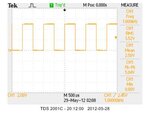D.A.(Tony)Stewart
Advanced Member level 7
- Joined
- Sep 26, 2007
- Messages
- 8,995
- Helped
- 1,823
- Reputation
- 3,645
- Reaction score
- 2,194
- Trophy points
- 1,413
- Location
- Richmond Hill, ON, Canada
- Activity points
- 59,490
RMS gives the equivalent to the integral over the time period when each digital reading is squared, then root of the Sum so it is said that RMS of AC+DC= equivalent True DC power.
more stuff I have used as a Test Engineer since the mid 70's
View attachment 74973
more stuff I have used as a Test Engineer since the mid 70's
View attachment 74973
